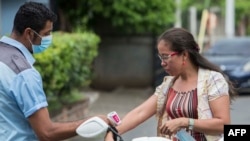On March 23, 41 years after a ruling junta dominated by the Sandinista National Liberation Front launched Nicaragua’s National Literacy Crusade, Nicaraguan President Daniel Ortega went on TV to talk about the nation’s efforts to end illiteracy.
In his speech, Ortega also brought up COVID-19. Nicaraguans “have to continue keeping the measures to prevent a greater number of contagions from occurring,” he said, adding that vaccines “will come for everyone” regardless of social status and that “the most serious cases” will be prioritized.
Just how Ortega will fulfill that pledge is unclear.
The president, who has frequently disappeared from public view for extended periods, has not explained his vaccination plans, how Nicaragua will obtain sufficient doses or how the economically troubled country will pay for them.
Critics say the Ortega government has not been transparent about its pandemic strategy. When it comes to vaccination, Rosario Murillo, Nicaragua’s vice president and Ortega’s wife, said in January that the government was working to acquire vaccines for 3.7 million people (about 55% of the population), CNN reported. For that, the Nicaraguan government was planning to acquire 7.4 million doses – 3.8 million doses of Russia’s Sputnik V, 1.5 million doses of the Moderna vaccine and 2.16 million doses of the Oxford-AstraZeneca vaccine.
Since then, little has been revealed about the status of vaccinations in Nicaragua. In late February, Murillo announced the first donation of vaccines to Nicaragua -- an unspecified number of doses of Russia’s Sputnik V, donated by the Russian government. Later, it was reported that only 6,000 doses were donated.
The Nicaraguan health ministry then announced it would begin “voluntary vaccination” for citizens on March 2, without detailing the schedule, locations or mechanisms.
Nicaragua reportedly received 200,000 doses of AstraZeneca’s Covishield vaccine from the Indian government, and another 135,000 doses of that vaccine donated by the World Health Organization’s (WHO) global vaccine-sharing program, COVAX.
That is a total of 341,000 doses, far fewer than the 7.4 million announced by Murillo. The doses provided by COVAX are part of a total of 432,000 to be delivered by May. That still puts the total magnitudes from the stated goal. In his speech, Ortega did not say where the rest of the shots would come from or when.
According to the Voice of America, medical personnel in Nicaragua have not been immunized, even though the WHO recommends that medical personnel get vaccinated first. Doctors in Nicaragua are demanding that the government publicize the National Vaccination Plan and make the population fully aware of the procedures to access the vaccine in an orderly manner.
To date, Nicaragua has officially reported more than 6,600 COVID-19 cases and 177 deaths from the disease. However, independent data from Citizen Observatory, which was established to track infections rates in the country, shows there have been nearly 13,300 suspected cases (i.e., confirmed by the group) and 3,009 deaths either by pneumonia or the coronavirus, which attacks the respiratory system.





